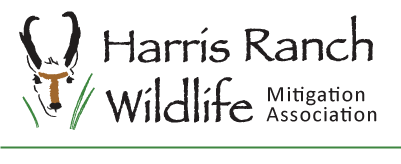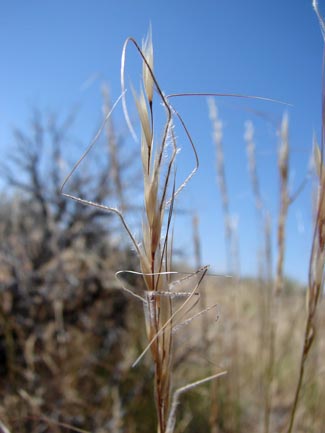
Grasses
Basin wildrye (Leymus cinereus) is a large, robust, bunchgrass native to the western United States. It is characterized by its deep blue-green color and impressive size. Basin wildrye is a long-lived, cool-season grass that forms large clumps and has a deep root system, It also provides cover for smaller animals and birds, including upland game birds. Bluebunch wheatgrass (Pseudoroegneria spicata) is a vital native species in the West. It's known for its blue-green foliage, erect stems, and drought tolerance. It once was a common component of sagebrush steppe. The plant can grow up to 4 feet tall and reproduces primarily through seeds. It is preferred and excellent forage for sheep, elk, deer, and antelope in spring.
Bottlebrush squirreltail (Elymus elymoides) is a native cool season perennial bunchgrass. It is known for its distinctive, bottlebrush-like seed heads as the seed matures. It's a drought-tolerant plant commonly found in dry, gravelly, or saline soils. It has nutrients needed for several animals including pronghorn, ground squirrels, rabbits, and deer. Idaho fescue (Festuca idahoensis) is a native, perennial, cool-season bunchgrass. Idaho fescue stemps are erect, up to a max of one meter tall, glabrous and glaucous, sparsely leaved with most leaves basal or coming from the bottom. The fine narrow leaves usually have a bluish green to green color. Idaho fescue is excellent forage for livestock and wildlife including elk, pronghorn, and mule deer. Indian ricegrass (Achnatherum hymenoides) is a native grass known for its wiry, sage-green foliage and airy appearance, with sage-green foliage that turns tan when dormant. It's a highly palatable grass for livestock and wildlife, and its seeds are also a food source for birds and small mammals. It is an important food source for winter months.Indian ricegrass seeds were a staple in the diets of many Native Americans. Needle and thread grass (Hesperostipa comata) is a native grass that can grow 1-3 feet tall. The leaves are smooth, flat with seeds that have sharply barbed awns (or hair like projects) giving the appearance of a short needle and thread. This plant is important forage in the spring before seed development and in the fall after seed drop. It is commonly grazed by mule deer. It thrives in sandy or rocky, dry habitats. Purple threeawn (Aristida purpurea) is one of the most common grasses in the Boise Foothills. It is a native, warm season grass (in contrast to many of our native grasses that are cool season) that can grow up to 18 inches tall. It's characterized by its distinctive reddish-purple awns, with long, hairlike bristles extending from the seed head. Red threeawn is not typically grazed by livestock or wildlife; though its seeds are eaten by some songbirds. It can occupy dry, disturbed sites that others cannot tolerate. Sand dropseed (Sporobolus cryptandrus) is a warm-season, perennial bunchgrass native to North America, particularly in sandy, arid regions. It's known for its drought tolerance and wind erosion control on sandy soils. This species produces a dense, sand binding network of roots which can spread up to 2 feet laterally and over 8 feet deep. Sand dropseed is an abundant seed producer. This plant is also important for native wildlife like pronghorn, mule deer, small mammals and game birds. This grass grows not only in sagebrush communities, but also in shadscale dominated communities. Sandberg bluegrass (Poa secunda) is a cool-season, drought tolerant, perennial bunchgrasses that matures in the early spring. It has potential to compete with cheatgrass because they both develop early in the growing season. This grass is one of the first to green up in the spring, but is cured and dormant by early summer. The plant usually occurs as small tufts. Sandberg bluegrass provides forage for livestock and is a nesting site for upland game birds, such as pheasants. Six weeks fescue (Vulpia octoflora), also known as eight-flowered fescue or six weeks fescue, is a native, cool-season annual grass that thrives in open, disturbed areas and can be found throughout much of North America. It typically grows to a height of 12 inches, although it can reach 24 inches in wet conditions. Thurber's needlegrass (Achnatherum thurberianum) is a cool-season perennial bunchgrass native to western North America, particularly the Great Basin and Intermountain West. It's a cool-season grass that thrives in semiarid environments, tolerating drought and cold, but not shade or salty soils. This grass is valuable for livestock and wildlife, providing forage, especially in the spring before seed heads develop, but can also be used for wind and water erosion control and restoration.
|
- Home
- Native Plants
- Grasses

